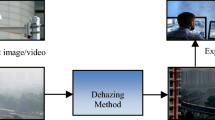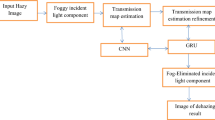Abstract
In the recent years, the vehicles are incorporated with camera-based modern driver support systems for facilitating the drivers to confirm their safety under different conditions of driving. However, lower contrast and faded scene visibility is considered as the main issue faced by the driver assistance system while driving in foggy weather conditions. At this juncture, deep neural network methods are considered to be potent in solving the limitations of manually designing haze-related features. In this paper, gradient flow-based deep residual network is utilized for improving the scenery images which are degraded through foggy weather conditions. This proposed scheme uses an undetermined complex function for mathematically modeling the fog in an image, which can be subsequently approximated by the deep residual network into the corresponding mathematical model associated with the fog. This proposed scheme uses two predominant steps that correspond to the determination of transmission map related to the haze image input and removal of foggy haze using residual network based on the estimation of the ratio between transmission map and foggy image. It is considered to be phenomenal in realizing generalization and robustness with minimal input for different unidentified image data. The experimental investigation of the proposed scheme is conducted using NYU2 depth dataset for the purpose of training the utilized residual deep networks. The experimental results proved that the proposed scheme is predominant over the benchmarked fog removal approaches in terms of evaluation metrics such as natural image quality evaluator aspect, blind/reference less image spatial quality evaluator, spatial–spectral entropy-based quality, full-reference metric peak signal to noise ratio, no-reference metric, feature similarity and structural similarity.





Similar content being viewed by others
References
Cai B, Xu X, Jia K, Qing C, Tao D (2016) DehazeNet: an end-to-end system for single image haze removal. IEEE Trans Image Process 25(11):5187–5198
Chen B, Huang S, Ye JH (2015) Hazy image restoration by bi-histogram modification. ACM Trans Intell Syst Technol 6(4):1–17
Dong T, Zhao G, Wu J, Ye Y, Shen Y (2019) Efficient traffic video dehazing using adaptive dark channel prior and spatial-temporal correlations. Sensors 19(7):1–19
Guo X, Li Y, Ling H (2017) LIME: low-light image enhancement via illumination map estimation. IEEE Trans Image Process 26(2):982–993
Hussain F, Jeong J (2016) Visibility enhancement of scene images degraded by foggy weather conditions with deep neural networks. J Sens 2016(3894832):1–9
Kim H (2019) Multiple vehicle tracking and classification system with a convolutional neural network. J Ambient Intell Humaniz Comput. https://doi.org/10.1007/s12652-019-01429-5
Li B, Wang S, Zheng J, Zheng L (2013) Single image haze removal using content-adaptive dark channel and post enhancement. IET Comput Vis 8(2):131–140
Li J, Li G, Fan H (2018) Image dehazing using residual-based deep CNN. IEEE Access 6(1):26831–26842
Liang Z, Liu H, Zhang B, Wang B (2014) Real-time hardware accelerator for single image haze removal using dark channel prior and guided filter. IEICE Electron Express 11(24):1–22
Liu X, Zhang H, Tang YY, Du J (2016) Scene-adaptive single image dehazing via opening dark channel model. IET Image Process 10(11):877–884
Mi Z, Zheng Y, Zhou H, Wang M (2016) Single image dehazing via multi-scale gradient domain contrast enhancement. IET Image Process 10(3):206–214
Mittal A, Moorthy AK, Bovik AC (2012) No-reference image quality assessment in the spatial domain. IEEE Trans Image Process 21(12):4695–4708
Pal NS, Lal S, Shinghal K (2018) Visibility enhancement of images degraded by hazy weather conditions using modified non-local approach. Optik 163(2):99–113
Pal NS, Lal S, Shinghal K (2019) A robust framework for visibility enhancement of foggy images. Eng Sci Technol Int J 22(1):22–32
Salazar Colores S, Moya-Sánchez EU, Ramos-Arreguín J, Cabal-Yépez E (2019) Statistical multidirectional line dark channel for single-image dehazing. IET Image Process 1(2):56–68
Shao S, Guo Y, Zhang Z, Yuan H (2019) Single remote sensing multispectral image dehazing based on a learning framework. Math Probl Eng 2019(1):1–8
Suran S, Sreekumar K (2016) Automatic aesthetic quality assessment of photographic images using deep convolutional neural network. In: 2016 International conference on information science (ICIS), vol 1, no 1, pp 23–34. https://doi.org/10.1109/INFOSCI.2016.7845304
Tripathi A, Mukhopadhyay S (2012) Single image fog removal using anisotropic diffusion. IET Image Process 6(7):966–975
Wang WJ, Chen BH, Huang SC (2013) A novel visibility restoration algorithm for single hazy images. In: IEEE international conference on systems, man, and cybernetics, vol 2, no 3, pp 847–851. https://doi.org/10.1109/SMC.2013.145
Wang S, Zheng J, Li B (2016) Parameter-adaptive nighttime image enhancement with multi-scale decomposition. IET Comput Vis J 10(5):425–432
Wang X, Ju M, Zhang D (2018) Automatic hazy image enhancement via haze distribution estimation. Adv Mech Eng 10(4):1–22
Zhang L, Wang S, Wang X (2018) Saliency-based dark channel prior model for single image haze removal. IET Image Process 12(6):1049–1055
Zhang S, Ng WW, Zhang J, Nugent CD, Irvine N, Wang T (2019) Evaluation of radial basis function neural network minimizing L-GEM for sensor-based activity recognition. J Ambient Intell Humaniz Comput. https://doi.org/10.1007/s12652-019-01246-w
Author information
Authors and Affiliations
Corresponding author
Additional information
Publisher's Note
Springer Nature remains neutral with regard to jurisdictional claims in published maps and institutional affiliations.
Rights and permissions
About this article
Cite this article
Suganya, R., Kanagavalli, R. Gradient flow-based deep residual networks for enhancing visibility of scenery images degraded by foggy weather conditions. J Ambient Intell Human Comput 12, 1503–1516 (2021). https://doi.org/10.1007/s12652-020-02225-2
Received:
Accepted:
Published:
Issue Date:
DOI: https://doi.org/10.1007/s12652-020-02225-2




